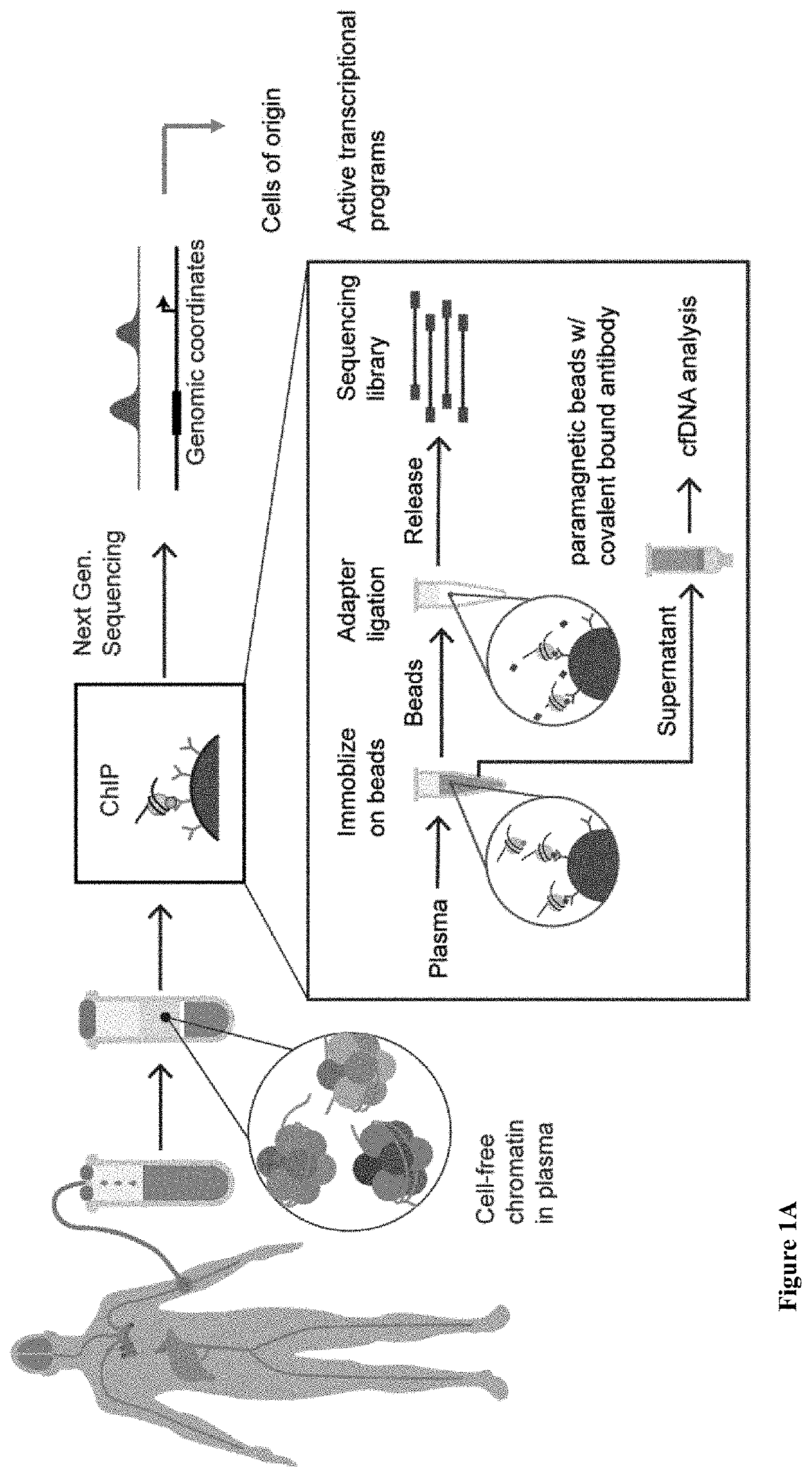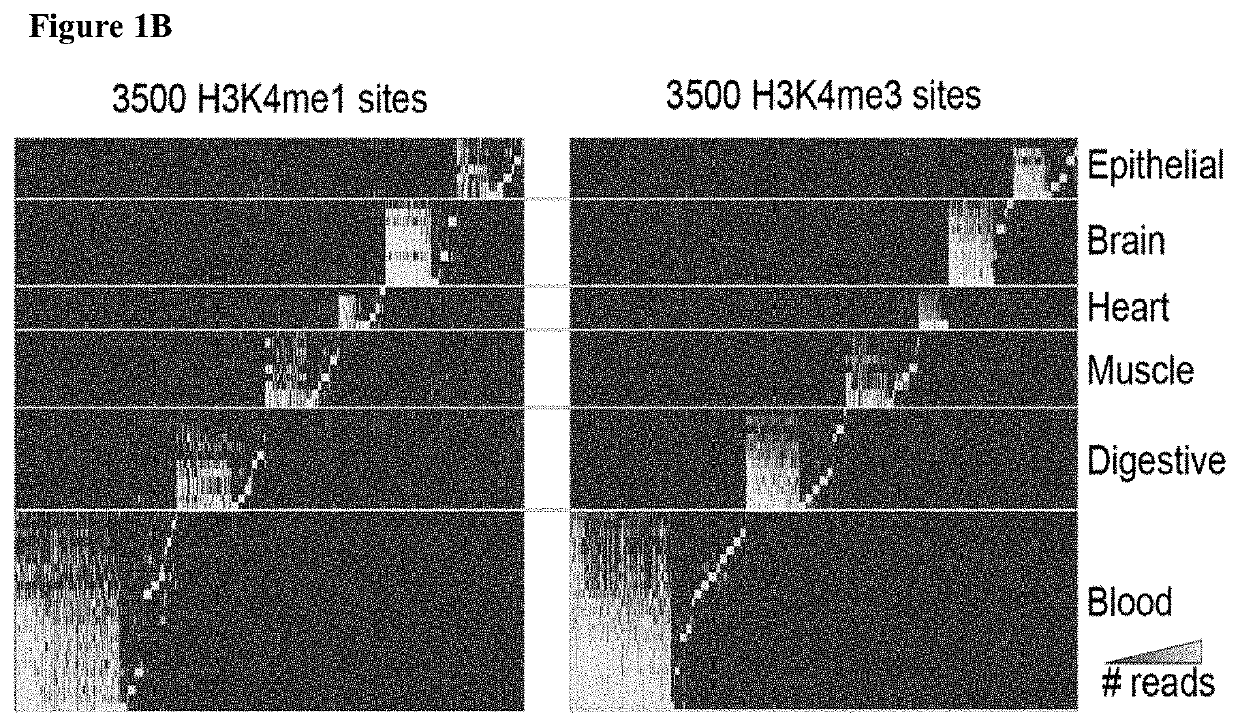Diagnostic use of cell free DNA chromatin immunoprecipitation
a chromatin immunoprecipitation and cell-free dna technology, applied in the field of cell-free dnaprotein complex analysis, can solve the problems of prohibitive harsh detection limits for events, difficult cfdna diagnosis of conditions from other tissues, and high sequencing depth for unbiased analysis of dna methylation
- Summary
- Abstract
- Description
- Claims
- Application Information
AI Technical Summary
Benefits of technology
Problems solved by technology
Method used
Image
Examples
example 1
Chromatin Immunoprecipitation of cf-Nucleosomes From Plasma
[0320]Most plasma cfDNA is likely in the form of nucleosomal DNA (cf-nucleosomes) with intact histone modifications. Whether extracting and sequencing DNA from cf-nucleosomes carrying specific histone marks could be used to determine information about the cell of origin of the cfDNA was investigated (FIG. 1A). This is approach is attractive for several reasons. First, ChIP experiments by design sequence only the positive signal reducing the number of reads required for a positive signal and thus lower the costs and work associated with the assay. Second, positive targets are relatively rare; promoter marks, such as H3K4me3, appear in ˜50,000 locations in the genome (<1% of the genome). Enhancer marks (e.g., H3K4me1) can appear in many regions (˜10% of the genome) but are limited in each cell. Third, histone marks are mostly tissue-specific. In particular, most enhancers are tissue-specific and thus provide strong H3K4me1 / 3 t...
example 2
cfChIP Detects Pathology Related Cell Death
[0329]The ability of cfChIP to identify signatures of cells from remote tissues suggested the exciting possibility for this tool to detect cf-nucleosomes originating from disease-related pathologic cell death. To test this hypothesis, we collected samples from patients diagnosed with acute myocardial infarction (AMI), a process that results in extensive cardiomyocyte cell death. We collected samples from patients admitted to the emergency room, with samples obtained both prior to, immediately after, and ˜12 hours following urgent percutaneous coronary intervention (PCI) to restore blood flow. We expect to observe cfChIP signal from myocardial cell death only in AMI patients but not in healthy subjects, particularly in samples following PCI.
[0330]As predicted, heart-specific H3K4me3 peaks were strongly and significantly detected in post-PCI patient samples, but not in samples from healthy individuals or from pre-PCI patients (FIG. 3A). The h...
example 3
Plasma Chromatin Reflects Gene Activity Patterns
[0336]A major challenge for cfDNA analysis is the inference of gene expression in the tissue of origin. The major approach proposed to this problem so far relied on under-representation of specific promoter elements in cfDNA as an indication of gene expression; however, this approach requires extremely deep sequencing and is limited to situations where cfDNA from the tissue of interest comprises a majority population in blood. We tested to what extent cfChIP can report on non-constitutive gene expression programs that took place in the cells of origin.
[0337]H3K4me3 is closely associated with transcriptional activity and dynamically changes in response to changes in transcriptional programs, raising the exciting possibility that cfChIP might be able to detect more dynamic transcriptional programs beyond the information on tissue of origin. To test this hypothesis, we compared the H3K4me3 cfChIP signal from patients with AMI or cancer to...
PUM
| Property | Measurement | Unit |
|---|---|---|
| Fraction | aaaaa | aaaaa |
| Time | aaaaa | aaaaa |
| Time | aaaaa | aaaaa |
Abstract
Description
Claims
Application Information
 Login to View More
Login to View More - R&D
- Intellectual Property
- Life Sciences
- Materials
- Tech Scout
- Unparalleled Data Quality
- Higher Quality Content
- 60% Fewer Hallucinations
Browse by: Latest US Patents, China's latest patents, Technical Efficacy Thesaurus, Application Domain, Technology Topic, Popular Technical Reports.
© 2025 PatSnap. All rights reserved.Legal|Privacy policy|Modern Slavery Act Transparency Statement|Sitemap|About US| Contact US: help@patsnap.com



